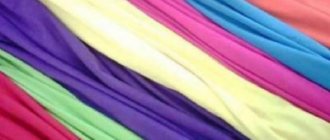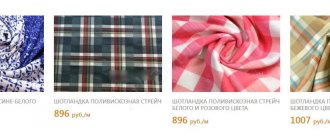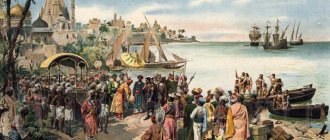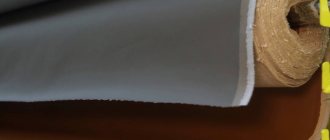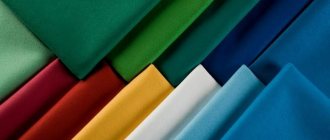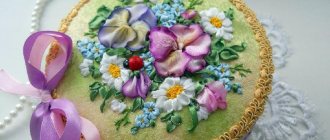History of fabric
Viscose is a young fabric. The technology for producing artificial fabric fibers from natural plant materials was invented at the end of the 19th century. Scientific developments were carried out earlier, but did not bring success. The French scientist Guiller de Chardonnay presented the world with the prototype of viscose in 1889. But his discovery did not spread further due to a significant drawback: the invented fabric was easily flammable.
Chemists from England Charles Cross and Edward Bevan improved the fabric production process and in 1892 received a patent for viscose. The material began to be used in the textile industry.
The name of the fabric comes from the Latin language, translated as “viscous”, reflects the process of creating the material from a thick viscous mass of recycled cellulose.
Viscose: pros and cons
Do you know what unites cellophane packaging for flowers, a viscose dress and a tarpaulin boot? Material. They are all made from viscose!
Viscose is rightfully considered the first fiber produced by man synthetically. The name of the fabric and material sounds approximately the same in all languages of the Earth and comes from the Latin word “viscum” - glue. Indeed, the raw material for producing viscose thread - a solution of cellulose xanthate in caustic soda - resembles bright orange glue or, in the presence of impurities, brown or green.
Viscose can be called the most natural of artificial fibers, because it is a reduced cellulose, that is, the composition of viscose is very close to the composition of natural plant fibers. The properties of pure viscose most closely resemble those of cotton. The fabric is pleasant to the touch, hygroscopic and breathable.
Pure viscose is translucent and shiny, making it look like silk. To get rid of shine (if it is undesirable), viscose is processed additionally or matting additives are added to the solution. Viscose does not accumulate static electricity. Viscose fiber is easier than cotton fiber to dye in any bright colors - after all, the dye can be introduced directly into the solution from which the thread will be restored.
However, viscose is not spared from the disadvantages of natural fabric: it easily wrinkles and is destroyed under the influence of atmospheric factors as a result of the combined action of water, oxygen, air oxides and ultraviolet radiation. Natural cotton is also subject to similar influences, but in addition to cellulose, it contains natural antioxidants and protection from sunlight, so cotton is more resistant to environmental influences than pure viscose.
Manufacturers of viscose yarn and fabrics take this feature of pure viscose into account and introduce additional components into it: chemical antioxidants and ultraviolet radiation filters, which allows them to extend the life of the fiber and, accordingly, the items made from it. When copper sulfate and ammonium hydroxide are added to a solution of viscose, copper-ammonia fiber is obtained.
The process of cellulose regeneration was first described by the Englishman J. Mercer in 1844. However, the industrial production of viscose fiber was invented almost half a century later, in the same England, in 1892 by Cross, Bevin and Beadle. A solution of cellulose xanthate in caustic soda was squeezed out in a thin stream into a container with acid - this is how a viscose thread was obtained.
England did not hold a monopoly on the production of viscose for long. In 1909, in France, packaging film - cellophane - was produced from a viscose solution. The properties of the new materials were highly appreciated by people, especially since the raw materials for their production were waste from the production of cotton fabrics and paper and sawdust. That is, the beautiful silk-like fabric and transparent packaging film were literally made from garbage!
It's funny that the exact chemical formula of cellulose was determined only in 1934, when the production of viscose was already in full swing. In the USSR, before the Second World War, they mastered the production of both viscose threads and cellophane, and in 1940 they came up with their own derivative of viscose - artificial leather - tarpaulin. However, those who happened to wear tarpaulin boots hardly remembered the inventor with a kind word.
But the beautiful viscose thread deserves only praise.
Typically, in yarn and fabrics, viscose is mixed with other fibers: cotton, linen, wool and silk - to obtain a cheaper material with virtually no loss of its “natural” qualities; with polyester - for strength and wear resistance, with lycra or elastane - to obtain an elastic “stretchy” fabric.
As part of the item on the label, viscose is indicated by consonant words written in Latin letters or the symbol Vi.
Viscose threads with their glassy sheen make excellent “ceremonial” fabrics: satin, velvet, jacquard. Equipped with matting additives, viscose can pretend to be wool, cotton or linen, and viscose knitwear is an excellent material for a summer dress or loungewear.
It seemed to me that the topic is interesting for everyone, because the thread itself makes you think, its softness and shine attract and set you up for creativity. Do you like this fiber? Can someone share their thoughts on this?
How it is produced
Viscose is produced from waste from the wood processing industry: tree bark and sawdust. The raw material for its creation is wood cellulose. The fiber creation process consists of successive steps.
- Prepare the raw materials. The wood is crushed into small chips and boiled in an alkaline solution under pressure for 24 hours. A gray viscous cellulose mass is obtained.
- The mass is squeezed through special small filters, forming fibers, and placed in an acid solution.
- The fibers are processed, given the required appearance and properties, bleached, and dyed.
- The resulting threads are dried.
Searched for with this fabric: bamboo fabric
Viscose threads can be divided into 3 groups:
- thin textile thread;
- durable and dense technical cord thread;
- short staple thread.
To create the fabric, various types of thread weave are used: plain, twill, satin, jacquard; products woven with finely patterned weaving are often found. The appearance of the fabric depends on the weaving method.
Application
- Viscose is used for sewing casual clothes for children and adults: dresses, skirts, T-shirts, blouses, shirts.
- The fabric is used to make beautiful evening dresses .
- The material is suitable for sewing home clothes , underwear and sleepwear.
- Home textiles are made from viscose : pillows, blankets, bedspreads, bed linen, curtains, tablecloths.
- The fabric is used as lining material .
- The material is used in the shoe industry to make the top layer of shoes.
Care
According to reviews, caring for a viscose item is easy. There are several recommendations that can make this easier:
- It should be washed at a temperature of no more than 40 degrees.
- It is advisable to choose a delicate cycle, or even better, wash by hand.
- Do not use aggressive detergents.
- The strength of the material when wet decreases, so do not squeeze or twist the item too much.
- Do not dry in the sun.
- Ironing should be done from the inside out and with a minimum heat level of the iron.
Description of the fabric: properties and composition
A special feature of viscose is that it absorbs the properties of the fibers included in its composition. Cotton gives it density and softness, elastane gives it elasticity and the ability to stretch according to the figure, polyester adds strength to the fabric and reduces wrinkles. By changing the combination of fibers in the fabric, one production technology can produce a variety of materials, in one case suitable for sewing transparent summer blouses, and in another - for the production of the lining of a warm coat. Viscose has a wide range of colors, from plain fabric of various colors to fabric with bright floral prints and original designs.
The basis of viscose fabric is cellulose. Additionally, the fabric may include cotton and synthetic threads.
Viscose by type of finish:
- smoothly painted;
- printed;
- variegated;
- bleached.
Kinds
Viscose fiber is produced colorless or dyed in the mass. The most popular types of viscose in light industry resemble natural fabrics.
- Natural 100% viscose . In its pure form, viscose is very soft and delicate. It wears out quickly and especially suffers from water. If a dry canvas has good strength characteristics, then a wet one is very easily damaged. Such popular names often found on labels as bamboo, tencel, modal, micromodal are made from viscose fibers. The only difference is in the raw materials and the technology for processing them.
- Knitwear made from viscose fibers . Viscose fibers are widely used in the production of knitted fabrics. This fabric is used for sewing sweaters, T-shirts and children's knitwear by the Ivashka children's knitwear factory. It is also popular among lingerie manufacturers. Can be used in knitwear as a monofilament, or serve as a base for creating other fabrics.
- With elastane . Does viscose stretch or not? The elasticity of viscose itself does not exceed 2-3%. If elastane is added to the fibers, the fabric becomes elastic. Elastane is introduced into the fabric in small quantities. With a ratio of 95% viscose and 5% elastane, the fabric stretches well. This composition is suitable for sewing women's and sportswear.
- Viscose oil. By adding polyester to viscose, a “butter” fabric is obtained. The material is a soft knitted fabric, pleasant to the touch. Products made from butter fit the figure well and are used in sewing dresses, skirts and blousons with flowing or form-fitting shapes.
Viscose is used to produce not only fabrics, but also non-woven materials used in light industry. - Cotton with viscose (cotton with viscose) . Viscose combined with cotton produces a stronger fiber. However, strength, just like pure viscose, is lost up to 55% when wet. The fabric is subject to shrinkage (up to 16%). The disadvantages do not apply to cotton-like staple rayon fibers. These include high-modulus and polynose viscose fibers.
- Viscose staple . The staple consists of short fibers of the same length. A short fiber length gives the fabric more elasticity. Therefore, staple fabric wrinkles less than other viscose fabrics and drapes well. The staple uses a printed, plain-dyed or multi-colored pattern. Cotton can be added to viscose. Shirts, blouses, long flowing skirts and romantic dresses are sewn from the staple.
- Lining . In the production of outerwear and headwear, viscose lining fabric is used. It provides protection to the base material, absorbs moisture well, and does not deform when worn. Viscose, like twill, glides well and is an ideal option for lining. In addition to viscose, lining fabrics can contain cotton and polyester.
- Quilted. Fashionable quilted shirts, dresses, leggings and jackets are made from viscose fiber that has undergone additional processing. Beautiful blankets are made from quilted viscose: patchwork blankets and other home textiles. The technology involves finishing the fabric with additional stitches. In this case, two layers of fabric are used.
Types of fabric, purpose and characteristics
- 100% viscose has no additives and consists entirely of cellulose fibers. The material is soft and delicate to the touch, shiny in appearance, low-strength and inelastic. Elasticity is 2-3%. Thin summer dresses are made from the fabric.
- Tencel is made from eucalyptus cellulose. It turns out to be soft and durable, breathable and hygroscopic, used for sewing bed linen and home textiles, and requires careful adherence to care rules to avoid deformation of the product.
- Modal contains 100% cellulose fibers or is diluted with cotton threads. This durable fabric wicks moisture away from the body, allows air to pass through, and is an artificial analogue of cotton. The fabric is used to make high-quality bed linen and casual clothing for adults and children.
- Acetate is made from cellulose waste. Lightweight, thin material, the distinctive properties of which are resistance to creasing and deformation. The fabric does not allow air to pass through well, absorbs little moisture, and is vulnerable to chemicals. Used as lining material.
- Cupra is viscose of the highest quality, with a texture reminiscent of silk. Used in sewing beautiful dresses, evening dresses and festive suits.
- Siblon consists of cellulose from coniferous trees. It is the result of long-term scientific experiments to improve viscose fabric. The material feels like natural silk to the touch and has all the positive qualities of viscose, enhanced by 1.5-2 times. The fabric is hygroscopic, breathable, not prone to shrinkage and creasing, and hygienic. Ideal for formal wear.
- Polyviscose consists of viscose and polyester fibers, combining their properties. The fabric is durable, warm, wear-resistant, wrinkle-resistant, ideal for sewing school uniforms and men's office suits.
Characteristics and properties
The characteristics of a material are influenced by its manufacturing technology. Therefore, the material has a different appearance. It can be: glossy and matte, textured and smooth, light and dense material.
Is viscose a synthetic or a natural fabric?
Consumers are interested in the question: is viscose synthetic or natural fabric? To understand this issue, you first need to clarify that people produce non-natural material using synthetics. To produce natural material, natural raw materials are used. For example, from sheep wool or silkworm threads. And to make viscose, wood and special chemical solutions are used.
You might be interested in Details about Pikachu fabric: description of properties
What is viscose and what does it consist of? It is generally accepted that fabric based on natural raw materials is a natural material.
Properties of viscose, stretches or not
The properties of viscose include the following:
- The material is soft and pleasant to the touch. Folds and drapery look beautiful in sewing products
- Hygroscopic - absorbs moisture well and allows air to pass through.
- Dry material has a high degree of strength, while wet 100% viscose has low strength. To increase strength and wear resistance, manufacturers add chemical additives to raw materials.
The disadvantages, as well as the advantages, in the fabric are compensated by various protective additives. Cotton added to viscose makes the fabric dense and increases its service life. To the question “does viscose wrinkle or not?” easy to answer. The material is strong with an oily sheen. Windbreakers and jackets are made from it. Used as lining material.
Many people are interested in: microviscose - what kind of fabric? If polyester is present in viscose, then the fabric does not wrinkle and retains its beautiful appearance. The elasticity of the material is given by the addition of elastane, which allows the fabric to stretch well.
Appearance of viscose
Advantages and disadvantages
The advantages of the fabric are:
- aesthetic qualities,
- beauty of appearance;
- ease;
- hypoallergenic;
- environmental friendliness;
- softness,
- pleasant tactile sensations from touching the body;
- heat-regulating properties;
- ability to pass air;
- hygroscopicity;
- antistatic;
- color fastness and brightness.
When dry, viscose is a durable fabric. When it becomes wet, it loses strength and becomes easily susceptible to mechanical stress.
Flaws:
- whimsical care;
- high creasing;
- vulnerability to high temperatures and ultraviolet radiation.
Comparison with cotton and polyester
“Cotton synthetics” is the common name for viscose among buyers. to polyester due to its artificial creation mechanism. But unlike synthetics, which are a completely chemical product, viscose is made from natural wood raw materials. Viscose differs from polyester in many qualitative characteristics. The properties of the fabric are more like cotton : it is light and pleasant to the body, absorbs moisture well, allows the body to breathe, and does not electrify.
Rules for caring for viscose fabric
In order for garments to retain their aesthetic appearance for a long time, they need to be properly cared for. This is a delicate fabric that does not require rough handling. The use of dry cleaning is allowed for the care of viscose products.
How to wash viscose
When washing, you should adhere to the following recommendations:
- use delicate mode;
- water temperature not higher than 40℃;
- Do not use a spinner to avoid creasing the fabric.
Important! The garment should look beautiful and not lose its shape, so it is better to wash it by hand and dry it flat.
How to iron viscose products?
Ironing rules:
- iron from the wrong side using the “silk” mode;
- the temperature of the iron should not exceed 150℃;
- iron through slightly damp cotton cloth.
If the fabric is ironed from the right side, iron marks will remain on it. They will differ from other areas of the product. And the high temperature of the iron can melt the material.
You might be interested in: Using Alcantara for car steering wheel and interior upholstery
Care instructions on the product label
Care instructions
It is difficult to care for viscose products. If washing and ironing rules are not followed, there is a high risk of deformation, shrinkage, and formation of pellets on the surface. To maintain the presentable appearance of the product, you must carefully follow the recommendations indicated by the manufacturers on the label.
General recommendations:
- It is better to wash products by hand; if machine washing is unavoidable, use the delicate wash mode;
- water temperature when washing is 30 degrees;
- do not use laundry detergents with aggressive chemical components;
- there is no need to forcefully wrinkle or rub the item, washing should be gentle and careful;
- do not twist the fabric, use a terry towel to wring it out: carefully lay the item on it and roll it into a roll, the towel will absorb excess moisture;
- You need to dry viscose products on a flat horizontal surface, having first carefully straightened them;
- iron at minimum iron temperature;
- steaming and spraying with water from a spray bottle when ironing is prohibited;
- Store away from direct sunlight.
Flaws
Despite its advantages and a number of positive features, viscose also has some disadvantages:
- Despite maintaining color characteristics for a long time, viscose quickly wears out and loses quality . After regular washing, pilling, stretch marks and gaps appear on clothes. Most often it is impossible to influence this. Even using the most gentle washing temperature and mode, the fabric will still become unusable over time. Dresses made of synthetic fiber quickly lose their shape and cease to have a silhouette. And if you wash such fabrics by hand and wring them vigorously, after a while it will stretch and lose its former appearance.
- Although clothes can be ironed, this does not always help in practice . In many cases, even after intensive steaming, folds and wrinkled fragments easily appear on the fabric.
- It is prohibited to bleach such items or use various stain removers . Aggressive components in such products will negatively affect the quality of the fabric. Therefore, in case of heavy contamination, you will have to use conventional methods.
- Poor quality processing of cellulose in production and the corresponding low cost of viscose clothing can cause more problems than positive aspects. For example, after the first wash, an inexpensive item may completely lose its original appearance and become unsuitable for going out.
Customer Reviews
Summer clothes made of viscose are popular; in hot weather it gives the skin a feeling of coolness. Buyers are pleased with the variety of colors of clothing and color fastness, lightness, softness. Users warn that the fabric absorbs foreign odors well, wrinkles a lot and becomes deformed if not properly cared for. There are endless debates about viscose: is it a natural material or is it synthetic? Despite its artificial origin, the fabric is popular in the fashion world; products made from it are actively purchased and worn well, are of high quality and provide comfort when worn.
General information
Viscose is a synthetic artificial fabric made from cellulose . The first production of the material occurred in the 19th century, and since then the fabric has been used to make clothing. Today, the production of artificial fiber in Russia is at the standard level and is practically not increasing. This is explained by the fact that production and processing require high costs, which is not always profitable.
The process of making viscose is multi-stage. The fabric undergoes thorough processing:
- First, the cellulose is crushed.
- Then it is boiled with calcium salt.
- Treated with alkali.
- Aged for some time.
- Treated with carbon disulfide.
- Passed through dies.
Clothing and other products are made from finished material. Clothes are made from thin threads. Lace and bed linen are made from denser threads. To create fabrics, both viscose in its pure form and with the addition of other materials are used. For example, cotton or polyester.
Today, the country has more imported viscose, which is most often supplied from China. The production of artificial fiber has recently become widespread in Uzbekistan. Depending on the manufacturer, type of material, the cost of clothing and its quality differs significantly. There are both budget clothes and more expensive ones.
To make a choice, you need to know the advantages and disadvantages of viscose clothing.
Video: what is viscose?
Watch an interesting video about what viscose is, what the material is made from, what properties the fabric has and what they depend on.
See similar articles
- Cotton is a popular natural fabric
- Soft - soft velvety fabric for interiors and outfits
- Blackout - light-proof dense fabric for curtains
- Tapestry - thick fabric with patterns for the interior
- 4 main types of fabrics, their properties and purpose
- Poplin - light and durable fabric for bed linen
If you liked the article, share it with your friends!



